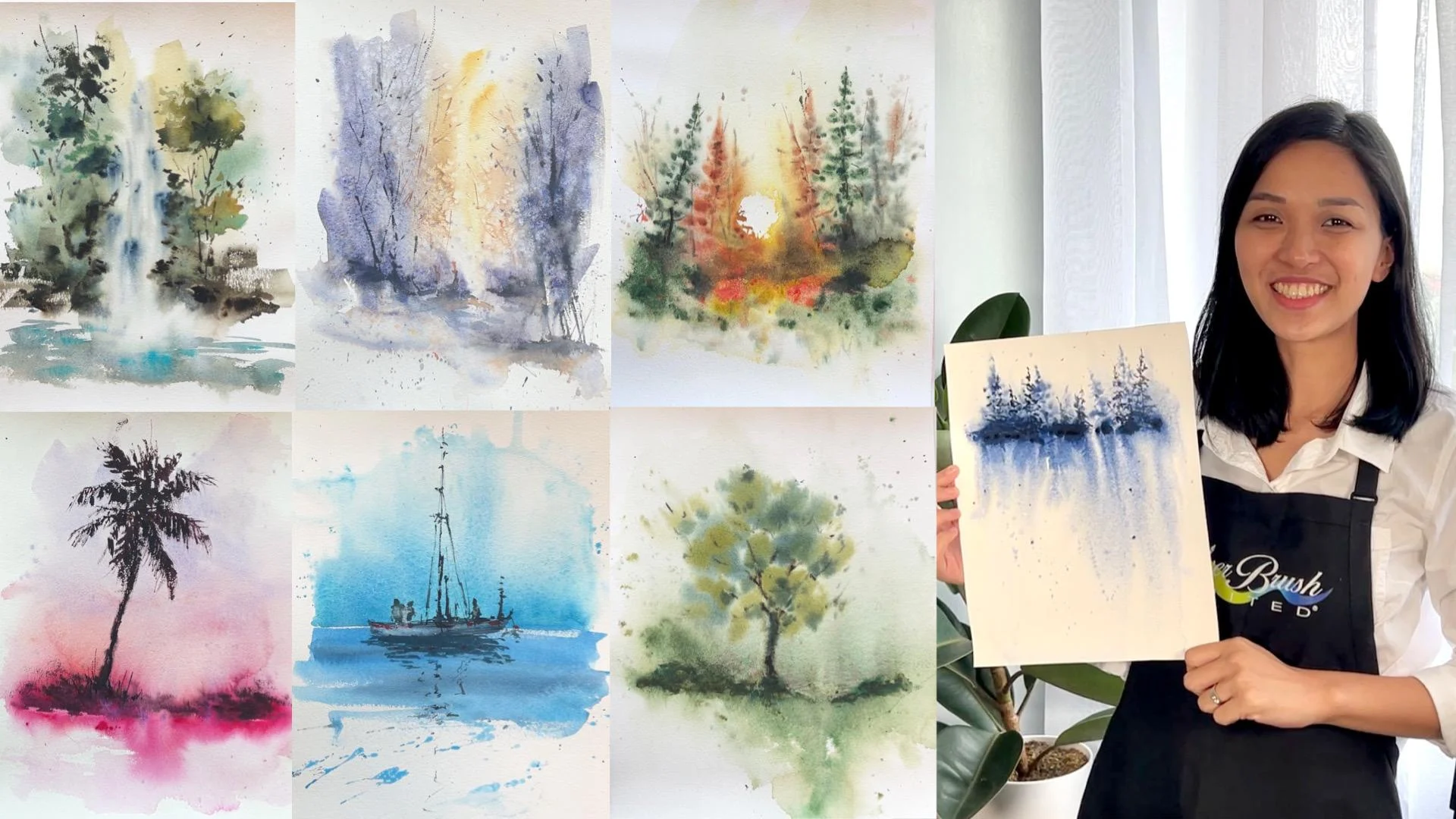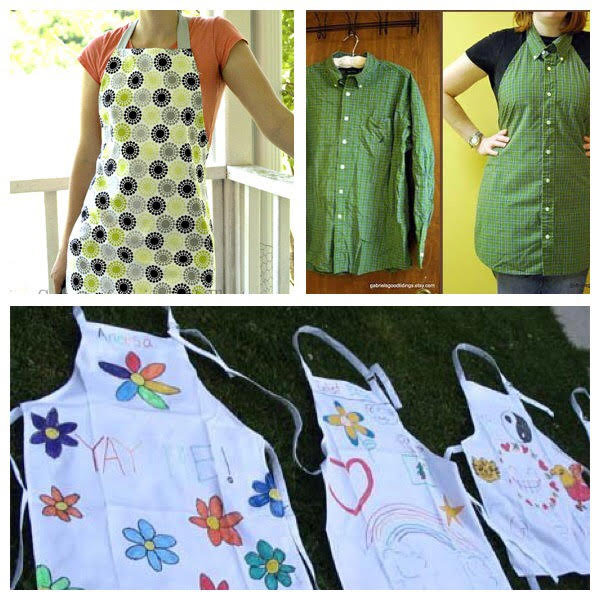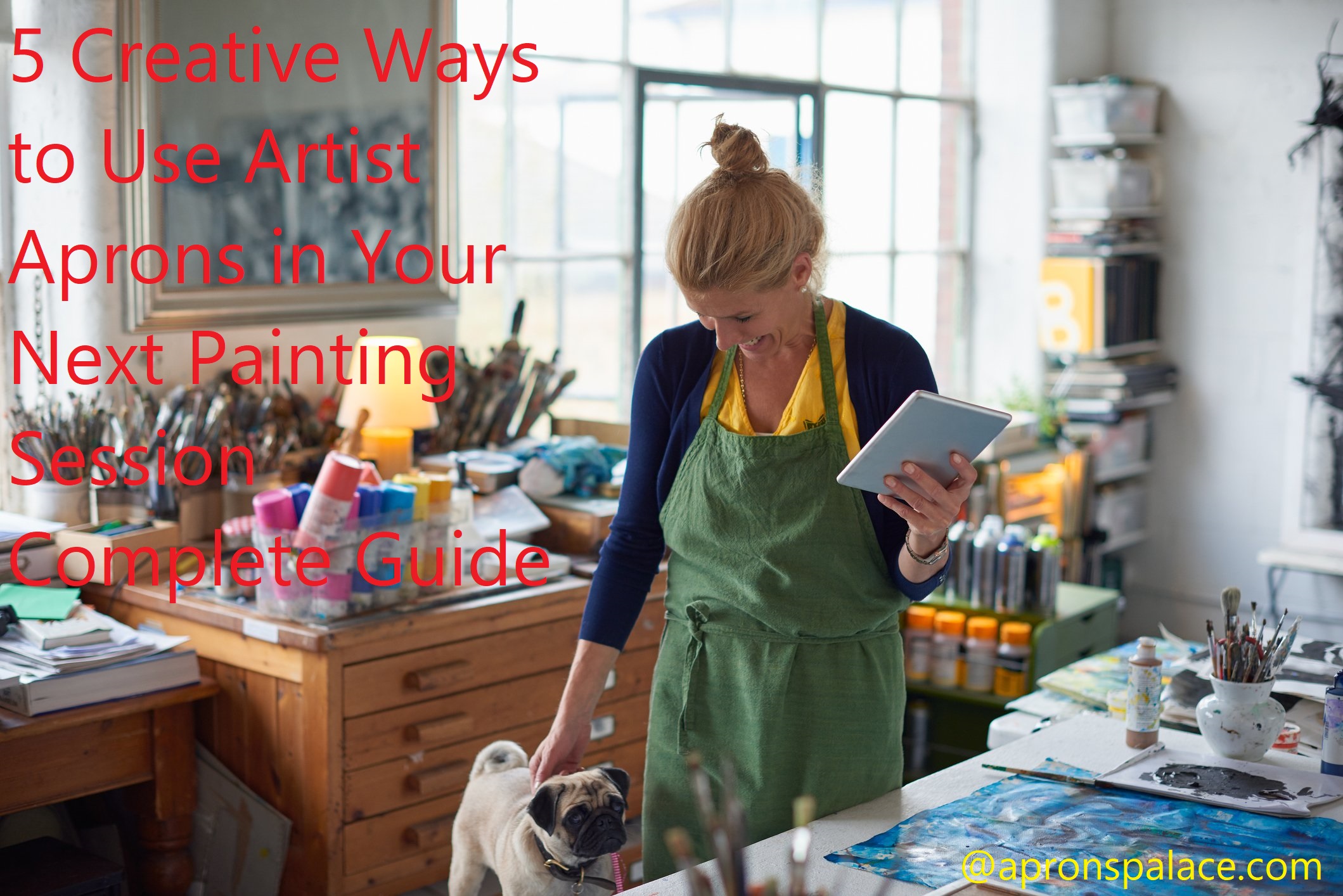Unleash your inner artist and take your painting game to the next level with these five unique ways to use artist aprons!
Whether you’re new to painting or a seasoned pro, you’ll love the convenience and flexibility of these aprons- perfect for any creative art session.
For any painter, having the right supplies and appropriate attire is essential for creative application. This is where the power of artist aprons comes in, as they offer a protective layer for clothing and art alike. By providing an added layer of coverage against spillage, artists can ensure their masterpiece stays intact from start to finish.
Beyond just their protective nature, artist aprons provide creative benefits as well. With multiple color options to choose from and fun motifs – like imaginative pockets – these aprons provide comfort during extended painting sessions and can also add flair. Read on to discover five unique ways you can use artist aprons in your next painting session!
Explanation of artist aprons
Artist aprons are perfect for protecting your clothing while painting or drawing and also serve to conveniently store materials. Retaining fabric aprons look like traditional bib-style aprons but have more pockets, straps, and other features designed to hold supplies and devices. The materials used range from light denim or chambray to heavy-duty canvases, waxed canvas and even neoprene.
These aprons are tailored specifically for artists, enabling them to work comfortably while having everything they need right at their fingertips. This can free up the artist’s hands so they can concentrate on the task at hand—creating art. Artist aprons come in various shapes, sizes, colors and patterns so you can find one that suits both your needs and aesthetic preferences. Here are 5 creative ways you can use an artist apron in your next painting session:
- Store Tools – Many of the pockets featured in these artist aprons make it easy for you to store clay tools, paint cans, brushes or any other art apparatus between uses.
- Easy Access – The straps on the back of an apron help secure it snugly around your body so you won’t have the hassle of readjusting constantly as you move around during your session.
- Keep Yourself Organized – Choose an apron with plenty of compartments and pockets so everything stays in its right place when you are creating artwork.
- Ready For Messy Work – If a medium like oil paint tends to leave trails of dried material on fabric then use a waterproof neoprene version that is easy to wipe clean after each session.
- Be Creative – Express yourself by selecting a fabric pattern that appeals specifically to your sense of style!
Importance of using artist aprons during painting sessions
Painting can be a messy and difficult task, but with appropriate protective gear, one can ensure that the job is done right without any mess. Artist aprons are great protective attire to wear while painting as they not only protect your clothes from hazardous paints and water but also make you look professional while working. It’s vital to wear artist aprons while painting; here are some benefits of using artist aprons during your painting session:
-Protection: Artist aprons provide effective protection against the hazards of hazardous material such as chemicals and paint splashes that could damage clothing. These aprons keep cloth materials safe from water or cleaning solutions wetting them, making them perfect for not just professional artists but also kids who like to get creative with their art projects.
-Durability: Most artist aprons are made with heavy-duty fabrics that are strong and durable enough to withstand repeated washes and paint spills. This ensures that you can use the apron for several sessions before needing to replace it. Additionally, these artists’ aprons come in different sizes so you can choose an appropriate one for yourself even if you are taller than average or plus size individuals.
-Organization: Artist’s aprons often feature pockets that help keep art supplies within easy reach when working in the studio or outdoors during an art project. These pockets improve organization at your painting station while helping reduce distractions caused by supplies constantly scattered around on tables and floors.
-Convenience: Wearing an artist’s apron eliminates the worry of stains or clumps on clothing sticking to your body after each session of painting since all debris is quickly wiped off onto the apron itself. This helps improve your level of comfort while ensuring safety since no harsh chemicals or strange particles mix up with skin contact either accidentally or unknowingly during each project session.
Creative Ways to Use Artist Aprons
If you love painting but hate having wet or stained clothing, artist aprons can be a great solution for your next project. Not only do they protect your clothes from mess, but with some creativity and imagination, you can use them to make your painting sessions more enjoyable. Here are five creative ways that you can use an artist apron in your next painting session:
- Put Your Easel on it – If you’re working on an oversized canvas, put your easel on top of the apron before setting it up. This will effectively shield your floor from accidental paint splatters and keep it clean while you work.
- Create a Palette Caddy – Put all of your paint palettes in the pockets of the artist apron so that they’re neatly tucked away and easy to access at any time. You won’t have to worry about them spilling or rolling off of the table this way!
- Store Brushes in the Pockets – Keep your brushes organized by storing them in their respective pockets within the artist aprons’ design. This will help keep them safe from harm during any unexpected movement while also streamlining clean up once your project is finished!
- Keep Your Canvas Protected – Place a damp cloth over the canvas before draping it over with an artist’s apron when completing intricate details or touch-ups to decrease smudging or splattering onto other parts of the artwork as well as clothing and furniture around you during higher intensity activities like detail work or heavy brush maintenance!
- Set Up Portable Storage Solutions – If you don’t have enough space for multiple projects set up at once, simply hang several different aprons off of pegs above one another to create portable storage solutions for all of your supplies! Plus, this will keep everything organized and out of sight so there won’t be any distractions!
Explanation of each creative way
There are many fun and creative ways to use an artist apron in your next painting session, and they can be a great addition to any artist’s arsenal. Here are five of the most popular ways to make use of an artist apron.
- Traditional Use – The traditional way for artists to wear an artist apron is with the neck loop secured over your head and the waist ties inserted through loops at the back. This allows for full coverage, from neck to wrist, while still allowing freedom of movement throughout your painting session.
- Wristlet Version – An alternative method of wearing an artist apron is with a wristlet made out of strong twill tape or webbing. Simply loop the webbing around each arm then tie it at the waist; this will provide comfortable yet secured collecting pockets at each hip, preventing any spills or accidents while painting up close.
3 Paint Can Holder – Artist aprons can provide you with quick access storage pockets for your brushes and paints without having to travel far from your canvas! Many aprons have specially designed pockets that fit standard-sized paint cans so keep all you need in reach during those long hours painting!
4 Waist Bag Vest- For those times when you need to travel beyond your canvas, you can transform your ordinary painter’s overalls into a waist bag vest that fits all kinds of supplies and conveniences for easy transport without compromising comfort or protection. This option also works well for storing materials such as sketchbooks, erasers, pencils or charcoals!
5 Protective Layer – Lastly, when dealing with hazardous materials such as acids or solvents , consider wearing an extra layer of Artist Apron over regular clothes; this way it provides additional protection against any solvents and helps prevent unnecessary skin contact during painting sessions while keeping safety in mind !
Personalization: customizing your apron to reflect your personality or the style of your artwork
Personalization is a great way to express yourself or add a unique touch to your artwork. Whether you decide to customize your artist’s apron with fun images, phrases, words or fabrics, you can create an apron that reflects your personal style. There are so many options available when it comes to creating the perfect personalized apron – from screen printing and fabric dying techniques to using upcycled materials like denim and crochet. If you choose this route make sure that whatever material is being used for decorative elements isn’t too thick or heavy because it will be uncomfortable to work with after several hours of painting.
Here are some creative ways for enhancing your artist’s aprons with personalization:
- Add Appliqués — Appliqués are the perfect way to express yourself in a creative way and make an impactful statement with your custom artist’s aprons. They can be adhered directly onto any fabric-based garment with heat-activated adhesive backing as well as via sewing machine. A wide range of appliqués featuring various sizes, shapes, characters are widely available on the market or you can even design your own unique one! For best results, opt for light features that won’t hinder movements during painting sessions.
- Embellish With Stickers — Stickers come in all sorts of shapes and sizes these days and they are an ideal choice if you want something quick and easy when it comes to customizing your next painting session attire. Choose fun designs around the topic of art like paintbrushes, canvas sheets or abstract figures for maximum effect! You do not have to limit yourself if traditional stickers don’t cut it; alternatively try vinyl stickers that go on top of fabric as highlights along edges or outlines; these give off a nice 3D effect when used effectively!
- Use Fabric Paint & Dyes — Using special fabric paint along with dyes is another great way for expressing yourself creatively through customizing your outfit between painting sessions! Whether applied directly over fabric or stencil method has been used – splashes of vivid colors combined together will truly liven up any canvas piece! Also consider adding special finishes such as patterning/texturing details along edges; this creates unique shiny effects which catch light beautifully depending on lighting conditions at use (e.g., outdoor/indoor).
4 Go Crazy With Embroidery/Embellishments — Create extra effects with adding embroidery thread detailing such as lines/shapes all over artist aprons; similar ideas can also be implemented using non-traditional materials such as sequins in lieu of threading method just mentioned earlier! Beads & charms offer interesting details especially when used at hemlines, cuffs & collars too! Experiment by mixing different materials together until desired look achieved.

Experimentation: using different types of aprons for different types of painting techniques or materials
One of the great things about artist aprons is that they can be used in a variety of different ways. Depending on the type of painting technique or material you are using, experimentation with different types of aprons can lead to interesting results. Here are five creative ways for you to use your artist apron in your next painting session:
- Wipe off excess paint – If you’re working on an intricate detail or a large painting, it can be helpful to have an extra layer of fabric like an apron to wipe away excess paint from your brush and surrounding area. An added bonus is that artist aprons often come with additional pockets where you can store small tools.
- Protect furniture from spills – Whether it’s a canvas, wood panel, or other surface that you’re working on, an artist apron provides added protection against accidental spills and splatters. The fabric also helps absorb excess paint so any mess caused by small accidents can easily be wiped away with no permanent damage done to the piece.
- Prevent smudging and fingerprints – If your painting requires precision details or smudging techniques then using protective layers like aprons help keep the artwork pristine while still allowing movement and precise work without compromising one’s own unique mark-making style.
- Protect clothes from stains – Artist aprons often have long straps so they reach over shoulders, giving the user extra coverage against any unexpected or rogue strokes while protecting clothing items underneath from stains that might otherwise be difficult to remove (especially ink).
- Create art from old/found aprons – Experimenting with mixed media techniques can add texture and interest to any project by incorporating different fabrics into artworks like stretching canvas onto old denim pockets for example. Found objects like antique/vintage aprons may not make great protective wear for painters but they do make interesting additions onto canvas in the form of collaged assemblages layered under paintings!
So if you love painting but find yourself getting frustrated at times due to messes or unwanted smudges, then consider experimenting with different types of artist aprons as part of your next painting experience! It might just bring unexpected surprises beyond what traditional brushes could achieve alone!
Protection: using aprons to protect your clothes and skin from paint splatters and stains
It’s obvious that when painting, you need to protect your clothes and skin from paint splatters and stains. But why not do it in style? Artist aprons can provide a great way to keep your clothes and skin free from paint, while still looking fashionable and put-together. Here are five creative ways to use artist aprons for your next painting session:
- Keep it casual: An apron is an easy way to stay comfortable and relaxed while working on your art. Choose an apron with pockets for easy access to paper towels or brushes during the session.
- Make it fashionable: Jazz up your look with a vibrant print or patterned artist apron. Why not match the colors of the cloth to the colors of the paints you are using?
- Creative Comfort: Aprons often have adjustable straps, allowing you to choose how cropped or full coverage you need while painted-up.
- Maximum Mobility: Aprons come in a variety of styles that allow you better movement while working on art pieces if desired – short wraparounds, long wraparounds, or full-length coverings can all be found!
- Accessorize: Some aprons come with eyelet holes for snaps or buttons that allow you add accessories like fringe trimmings or buckets of beads at the waistline; might be great fun addition when heading out for an outdoor painting session!
With these creative ideas in mind, next time will definitely be an easier (and stylish!) time when preparing for any art session!
Care and Maintenance of Artist Aprons
The care and maintenance of your artist apron is the key to long-term satisfaction. To ensure best performance, only use cold to lukewarm water for cleaning and maintain a regular cleaning schedule. Always lay your apron flat to dry in an open, well-ventilated area, away from direct sunlight and other sources of heat.
After each painting session, be sure to check the pockets of your apron for any residues or paint bumps and clean them out as needed. For persistent marks on natural fabric aprons try using soap formulated specifically for colored fabrics or stain remover from a trusted brand. In addition, use protective sprays that can help repel liquids to prevent dirt and dust marks from accumulating on the surface of your artist apron.
When exposed to high temperatures such as during ironing periods, natural fabrics may shrink or stretch out of shape; therefore, when caring for artist aprons always use low temperatures with steamless presses—which are ideal for removing wrinkles—or you may lay the item flat after each washing session until fully dry before pressing it lightly with an iron set at gentle level heat. Lastly, never put fabrics in dryers—air drying will create less wear on the fabric over time than machine drying would increase its life cycle significantly while protecting it from further damage caused by heat sources.
Tips for keeping your apron in good condition
When it comes to successfully using artist aprons in your artwork, you will need to make sure they are properly maintained. With a few simple tips and techniques, your artist apron can stay looking as good as new for years to come. Here are five essential practices for keeping your artist apron in good condition:
- Clean it regularly – When painting with acrylics or oil paints, be sure to wipe off excess paint from the surface of your apron. This will help keep the fabric looking nice and avoid any permanent staining. In addition, give your apron a thorough cleaning with soap and water every few months or so to help keep it smelling fresh.
- Air-dry after use – After any painting session, make sure the apron is hung up and allowed to air-dry thoroughly before being stored away. This prevents moisture from getting trapped in the fabric and causing mold or mildew growth on the surface of the material.
- Store away from direct light – Sun exposure can fade the color of any fabric over time, so try storing an artist apron away from windows or other sources of bright light when not in use for long periods of time.
- Use cold water when laundering– Warm or hot water can prematurely wear fabrics out over time, so pay attention to any specific instructions on an artist apron’s label and only use cold water when laundering it at home. Additionally, be sure never to put an apron into the dryer! Traditional fabrics may shrink when exposed to high temperatures while synthetic materials tend to stretch out permanently if dried via machine drying methods—avoid this altogether by air-drying garments as recommended above!
- Touch up spots/stains– If there are any discolorations on an artist’s garment due to oil paint or ammaritismo (a natural dye that is used in traditional painting practices), try spot cleaning these areas before laundering them fully with soap and water or another suitable cleaning solution—always make sure test out products on scrap pieces of material first!
Washing: knowing how to properly wash and dry your apron to prevent damage or shrinkage
Washing your artist apron regularly helps to make sure you look neat and professional while you’re painting, but knowing how to properly wash and dry it can help prevent damage or shrinkage.
Generally, most aprons are machine-washable and may be laundered with other items in your home. Remember that heavier fabrics like denim and canvas should be washed separately from lighter fabrics like cottons or linens. It’s also important to adjust the water temperature based on the fabric of your apron – warm water works well for most materials, but heavier materials should use cold water only.
After washing, make sure to hang the apron up to air-dry in its natural shape – drying it on a radiator or in direct sunlight can cause shrinkage or fading.
Stain Removal: using different methods to remove paint stains from aprons
If you’ve ever painted before, you know that paint stains can be difficult to get out of artist apron garments. Whether it’s oil paint or acrylic, watercolor or fabric paint; getting rid of stubborn paint stains can be a challenge and require some creative methods. To help you tackle that task we have put together this comprehensive guide on how to remove common art related stains from aprons and other fabric items.
Using Solvents: There are many solvents—such as mineral spirits, turpentine, nail polish remover, paint thinner and more—that can be used to dissolve certain types of stains like oil-based paints. Solvents work best on when the stain is still wet but can also be utilized after drying. However proceeding with caution is suggested—when using solvents take safety precautions as well as test on a small area before applying to the stain itself as certain substances may change or damage the color or texture of your garment fabric when being exposed for too long.
Using Paint Stripper: If a stain has been completely dried onto an apron surface it might require something more abrasive; in this case a thick layer of paint stripper could be used. Paint stripper removes dried up layers of Acrylic and latex paints in various ways; concentrates such as Brush-on Stripper gel works great while sprays are convenient if covering larger areas with less precision needed as well.
Using Stain Removers/Laundry Detergent & Water: Most commercial laundry detergents are optimized for removing heavy duty type of messes by penetrating within your garment’s grain where dirt & any oily residue may reside between fibres & threads accumulating over time—coupled with warm water it’s make for an effective technique (following directions noted on back label). It boasts effective results without harming delicate fabrics indefinitely increasing their life span in the process not just ridding hard dirt but preserving memory strength to resist future daily wear and tear likewise preventing further wear & tear during everyday use later down the line (Note: Spot test any detergent agent beforehand).

Storage: storing your apron properly to prevent damage or wrinkles
It is important to store your artist apron in a manner that will help keep it wrinkle-free and looking great. You can easily do this by rolling the apron from top to bottom, rather than folding it, which can damage the fabric or create unwanted wrinkles or creases.
Make sure you take care when rolling up your artist apron so that you don’t stretch any part of the fabric. Once it’s rolled up, use twine or rubber bands to hold it together so that it stays in place until your next painting session.
After your session is finished, remember to brush off any dust particles from the apron before re-rolling and storing. This will help keep your apron in perfect condition for longer.
Conclusion
In conclusion, artist aprons are a great accessory to have on hand during painting sessions. Not only do they help keep your clothes clean and paint off of your skin but they also add an element of style and protection.
There are many unique ways to use aprons depending on the materials you are using for your project, such as stencils, canvas backpacks and other accessories. Whether you’re painting indoors or outdoors, these protective garments will come in handy by ensuring that everything you need is always within reach and that you don’t sacrifice any of the quality of your masterpiece.
Remember to choose an apron that is both stylish and practical so that it can be used time and time again in future art projects!
FAQ’s
How can you make your art in more creative ways?
You can try experimenting with new techniques, materials, or subject matters. You can also seek inspiration from other artists or your surroundings, and challenge yourself to think outside the box.
Do painters use aprons?
Yes, many painters use aprons to protect their clothing from paint and other materials.
What is the use of apron in painting?
The main use of an apron in painting is to protect the painter’s clothing from getting stained or damaged by paint, solvents, or other materials.
How should an apron be used?
An apron should be worn over the painter’s clothing, with the front of the apron covering the torso and legs. The painter should make sure that the apron is securely fastened and fits comfortably.
What is a painter’s apron called?
A painter’s apron is sometimes called a smock or an overall.
What is an art apron?
An art apron is a type of apron that is designed for artists, usually made from a durable and easy-to-clean material like canvas or denim.
What is an apron used to protect?
An apron is typically used to protect the wearer’s clothing from getting stained, dirty, or damaged by various substances, including paint, food, and chemicals.
What do aprons protect you from?
Aprons can protect you from a variety of substances and hazards, including spills, stains, splatters, and cuts.
What is the importance of an apron?
The importance of an apron is to protect the wearer’s clothing and skin from potentially harmful or messy substances, and to help keep them clean and comfortable while working.
What are the features of an apron?
Features of an apron can include adjustable straps, pockets for tools or supplies, water-resistant or fire-retardant materials, and various styles and designs for different types of work.
See more-
- Best kids aprons 2023
- Best welding aprons 2023
- Best workshop aprons 2023
- Best work aprons 2023
- Best woodworking aprons 2023

Douglas Keefer is the CEO and author of apronspalace.com and Informative Website. With his extensive knowledge and expertise in the world of aprons, he has helped thousands of people find the perfect apron for their needs. Douglas’s commitment to transparency and honesty has made apronspalace.com stand out in a sea of biased reviews and sponsored content. He is a true pioneer in the world of aprons and a passionate advocate for the culinary arts



